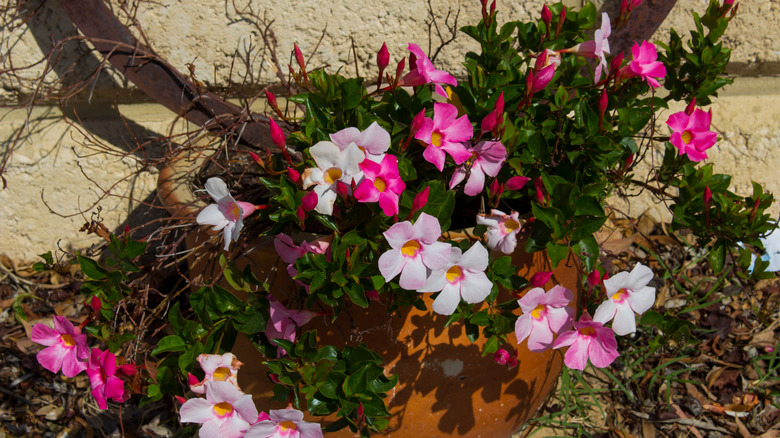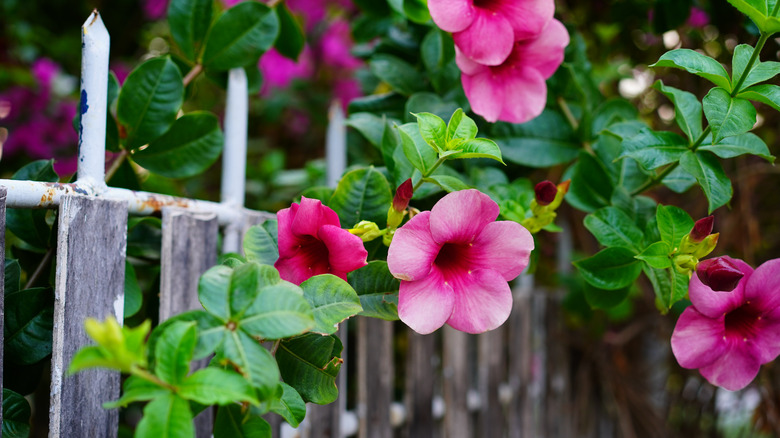Most often referred to as the golden trumpet, Allamanda cathartica is a flowering vine native to Central and South America. It was first described and classified by the great Carl Linnaeus, considered one of the most influential and important botanists in history, as per the University of California, Berkeley. He named this robust flower after Dr. Frédéric-Louis Allamand, a fellow botanist and friend from Switzerland. Bright yellow is the most common color for allamanda flowers, hence the golden nickname, but you can also find the blooms in gorgeous shades of pink and peach.
Kew Royal Botanical Gardens describes the leaves of the allamanda as lance-shaped, meaning they taper from base to tip. Individual leaves tend to grow a few inches long and about 1 inch wide. That size pales compared to the glorious trumpet-shaped blossoms, which can be close to 4 inches long and over 2 inches wide. Each vine of this often mammoth-sized plant has the potential to stretch well over 20 feet high.
Fifteen Allamanda species have been classified so far; the latest discovery occurred in 2009. Even though this happened in Brazil, where the plant is commonly found, research shows that the original introduction of the golden trumpet vine made its way to South America from Africa as many as 20 million years ago. These days, allamandas have spread across the globe and naturalized themselves into many tropical locations, including the rainforests of Queensland, Australia. They are popular in USDA hardiness zones 10 and higher within the United States, where you can find them gracing many a landscape in places like South Florida and much of California.
Alamanda, also known as golden trumpet vine, is a stunning tropical plant known for its beautiful yellow trumpet-shaped flowers. If you’re growing alamanda in your garden, you’ll want to harvest the flowers to enjoy their beauty indoors or share with friends. But when is the best time to harvest alamanda blooms? And what are some techniques to ensure you get the highest quality flowers? In this comprehensive guide, we’ll go over everything you need to know about harvesting your alamanda plant.
When is the Best Time to Harvest Alamanda Flowers?
Timing is critical when harvesting alamanda. Here are some tips on identifying peak seasons and optimal daily harvest times:
-
Blooming season – Alamanda typically blooms most prolifically from late spring through early fall. During this peak blooming period, plants will be covered in flowers ready for picking
-
Morning harvest – Harvest alamanda flowers in the morning when they are fully open and before the day’s heat causes them to wilt Early morning hours mean the blooms will be freshest
-
Harvest frequently – Don’t wait for flowers to fade before harvesting Pick blooms as soon as they reach full size and brilliance Frequent harvesting encourages new buds to form,
-
Avoid hot weather – Refrain from harvesting in very hot, sunny midday conditions. The heat will cause alamanda flowers to wilt rapidly after cutting.
-
Monitor buds – Keep an eye on your plant and cut blooms just as new buds emerge. This ensures you get flowers at their peak.
Step-by-Step Techniques for Harvesting Alamanda
Follow these simple steps for successfully harvesting your alamanda flowers:
1. Gather Your Supplies
- Sharp, clean pruners or scissors
- Container of water to hold cut stems
- Floral preservative (optional)
2. Identify Flowers to Cut
- Look for fully open, bright yellow blooms at their peak.
- Avoid buds that haven’t opened or flowers starting to fade.
3. Snip Stems at an Angle
- Cut each stem at a 45 degree angle above a leaf node.
- A slanted cut allows more water uptake.
4. Strip Away Excess Foliage
- Remove any leaves or stems that would sit below the water line.
- Leaves left in water will decay and harbor bacteria.
5. Immediately Place in Water
- Put freshly cut stems directly into a bucket of water.
- This prevents air embolisms that can block water flow.
6. Use Floral Preservative (Optional)
- Consider adding floral preservative to the water to prolong vase life.
- Preservatives have nutrients and anti-microbial agents.
7. Display or Store Properly
- To enjoy indoors, place in a vase with fresh water.
- For storage, wrap stems in a damp paper towel and refrigerate.
Tips for Getting the Most from Your Alamanda Harvest
Follow these expert tips to maximize the yield and quality of your alamanda harvest:
-
Harvest frequently to encourage continual new blooming. Alamanda responds well to regular cutting.
-
When harvesting, always leave some buds and flowers on the plant. Removing all blooms can shock alamanda.
-
Use clean, sterilized pruners for each cut to prevent spreading disease between stems.
-
Recut stem ends that have been out of water for more than 10 minutes. This restores water uptake ability.
-
Remove thorns and leaves from harvested stems to prevent injuries and keep water clean.
-
Transport harvested stems with care to avoid crushing delicate petals. Use buckets of water to hold stems.
-
Display alamanda flowers out of direct sun to prolong their vase life. These tropical blooms prefer moderate light.
Common Questions about Harvesting Alamanda
If you’re new to growing alamanda, you likely have some questions about knowing when and how to cut those coveted flowers. Here are answers to some frequently asked questions:
How Often Can Alamanda Be Harvested?
Alamanda responds very well to frequent harvesting. Snip blooms as soon as they reach maturity, which will spur ongoing flower production. You can cut blooms every few days during peak flowering seasons.
Can You Harvest Alamanda in Hot Weather?
It’s best to avoid harvesting alamanda during very hot, sunny conditions. The heat will accelerate water loss, causing blooms to wilt rapidly after cutting. For best results, harvest in the morning before heat builds.
How Long Do Cut Alamanda Flowers Last?
With proper care, cut alamanda blooms can look beautiful for 5-7 days or even longer indoors. Use floral preservative and refresh water daily for maximum vase life. Avoid exposing arrangements to heat sources or direct sun.
What’s the Best Tool for Cutting Alamanda Stems?
Sharp bypass pruners or gardening scissors are ideal for harvesting alamanda. Make sure tools are clean and sterilized before use to prevent spreading disease between plants. Aim for cuts at a 45 degree angle.
Can You Store Extra Alamanda Stems?
Yes! Any leftover unneeded stems can be refrigerated to extend their lifespan. Wrap dry stems in a damp paper towel and place in a plastic bag in the fridge. Properly stored, they’ll last for 1-2 weeks before arranging.
Get Ready to Enjoy Bountiful Blooms
With the right timing and techniques, you can enjoy harvesting buckets of vibrant alamanda blooms. Pay attention to seasonal flowering cycles, harvest in cool morning conditions, use proper cutting and storage methods, and your hard work will pay off in bouquets of beautiful flowers. Ready those pruners and get ready to start snipping!

Container growing and repotting allamanda vines

Just because this is a large plant doesnt mean it cant be a happy container or houseplant. Per Gardening Know How, so long as youve got a window with the right amount of exposure, you can grow a healthy flowering vine indoors. One of the benefits of growing allamanda in a container is that it will be easier to maintain at a smaller size. Youll just need to stay on top of a pruning schedule to keep it to scale.
Think “tropical” and “greenhouse” when setting up space inside your home for your colorful guests. Supplemental full spectrum lighting and a humidifier will come in handy for anyone attempting to grow indoor tropical plants in a northern climate zone. When it comes time to pot, an even mix of peat, compost, and sand will make it feel right at home. Never forget the drainage holes!
Regardless of how far back you intend to prune it, your vine will still need some sort of support. Indoors, you can use simple stakes or small bamboo tripods. Ohio Tropics offers up a seven-step tutorial for making your own moss pole. Its a pretty simple DIY project that can benefit your allamanda vine tremendously by mimicking the conditions it would otherwise find in the natural world.
If your golden trumpet outgrows its container, youll need to consider repotting it into something larger. When choosing a new container, only go up a few inches in diameter. Anything bigger can make it difficult for roots to pull water from the surrounding soil. All plants will acclimate to whatever soil theyre given, so it is advisable to use a fresh mix of exactly the same kind of soil its already growing in. To further reduce the incidence of transplant shock, work quickly so those fragile root systems are not exposed to any elements or temperature changes for long.
How to use a flowering allamanda vine in the garden

Because a flowering allamanda vine can become quite large (over 20 feet long), making the best use of it in a landscape or garden setting requires a bit of advance planning. Some vine species send out twining tendrils which allow them to secure themselves to the ground or trunks of other trees. Per South Florida Plant Guide, the allamanda vine has no such method of attachment and, therefore, needs a little guidance as it continues to grow. Luckily, its relatively obedient and will take direction well. Secure your allamanda along a fence, use it to adorn the length of a deck railing, or train it to grow up and over an arbor or trellis. Whichever way you choose to go with your plant, a support structure will be important for this one unless you plan to keep it trimmed back in shrub form.
If, on the other hand, you balk at the mere suggestion of telling your plants what to do or where to grow, you could opt to let them do their own thing. Left to its own devices, this wild child will ramble loosely, cottage garden style. The most important factor to keep in mind is that allamanda vines require full sun to produce an abundance of blooms. When planting, give each vine room to grow by keeping other plants at least 3 feet away. Expect shrubs to become bushy and spread to around 5 feet wide.
